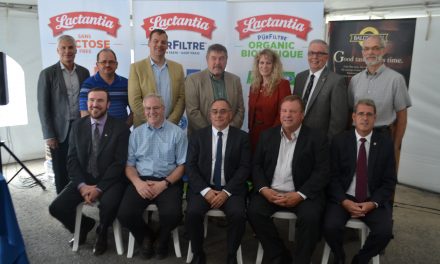Meet the 2017-2018 LFA county directors
Gathering for a photo following the Oct. 12 AGM of the Lanark Federation of Agriculture are the 2017-2018 county directors for the LFA. From left, in front are Deb Knapton (member service representative), Ted Letts, Lillian Drummond and Dave Campbell; in the back row are Lorne Heslop, Jamie Fortune, Richard Kidd, Andrea McCoy-Naperstkow, Debra Pretty-Straathof (regional representative), Rosemary Kralic and Alvin Dobbie. Missing from the photo are directors Roy Lightbody and Bruce Nolan. Pinder-Moss photo
by Dianne Pinder-Moss
AgriNews Contributor
LANARK COUNTY – While there are many issues the Lanark Federation of Agriculture (LFA) deals with each year, two major topics of concern for members this summer were crop insurance and municipal land tax assessments.
To address these subjects, representatives of Agricorp and Municipal Property Assessment Corporation (MPAC) were invited to be the guest speakers for the annual general meeting of the LFA held on Oct. 12 at Brunton Community Hall in Beckwith Township.
The first presentation of the evening was by Wendell Joyce, regional manager with Agricorp. He provided an overview of some of the programs the provincial government agency delivers on behalf of the federal and provincial governments.
While Joyce noted that Production Insurance (PI) – more commonly known as crop insurance – was probably the best known of the programs, he also made mention of others like the Risk Management Program and AgriInvest and how they could benefit local producers. For those who were already clients of Agricorp and have crop insurance, his suggestion was to review their coverage once the harvest season was over to determine the best fit for next year.
Joyce mentioned some of the reasons he hears for people not having crop insurance. The first one, that there cannot possibly be two bad years in a row, earned some chuckles from the approximately 50 in attendance. Another was that people pay premiums and don’t receive anything in return.
To debunk that perception, Joyce provided a sampling of 10 of 76 farm customers in Lanark County. He reported that these 10 clients had paid $640,000 in premiums and received approximately $1.6-million in claims during their participation in the PI program.
“(In this case), there’s a ratio of $2.60 of claim for every dollar of premium paid over the history,” he stated, adding that none of the farms had paid out what they had received back in claims. In addition, he noted that only one of the 10 did not have a corn or soybean claim.
Joyce provided a breakdown of the crops for which coverage was provided in the 179 PI contracts the 76 farm clients of Agricorp in the county have in 2017. They are as follows: Corn – 6,100 acres; Soybeans – 10,200 acres; Barley/oats/spring grain/spring wheat – 1,400 acres; Winter wheat – 1,200 acres; and Forage rainfall – 5,600 acres.
Joyce highlighted the fact that PI coverage is available for 100 different plans. That includes vegetable crops, honey and the bees themselves, fruit trees and strawberries, etc. To date this year, 31 claims totalling $300,000 have already been paid out for just unseeded acreage benefits.
“We expect we are going to be busy again this fall like we were last fall but for exactly the opposite reason,” Joyce remarked. He made that comment after referring to a rainfall map, which showed that areas east of Belleville, including Lanark County, received “well over double” the normal rainfall from May to August of this year.
Joyce reminded the LFA members attending the AGM that the premium costs of PI are shared with the federal and provincial governments.
“You are getting (approximately) half-priced insurance,” he said.
Anyone with questions or seeking further information on the programs offered by Agricorp were invited to call the agency’s toll-free number at 1-888-247-4999.
From Agricorp, the conversation moved to farm property assessments as two regional MPAC representatives spoke at the AGM. Beverley Disney, account manager of municipal and stakeholder relations department in MPAC’s Brockville office, outlined the process used in the most recent assessment of properties in 2016, which provides a basis for taxation over a four-year period until 2020. Of the over five million properties assessed, 222,993 were farm properties with a total assessment value of more than $100-billion.
Disney also spoke about changes that had been made to the assessment process. Among these were the redesign of the property assessment notices to make them easier to read and the province introducing legislative changes in support of the early notice mailing to allow property owners 120 days from the issue date of their Property Assessment Notice to file a 2017 tax year request for reconsideration.
As well, the AboutMyProperty online service was revamped. Whereas previously information was only available on the site to residential property owners, “for the first time we were able to welcome farm properties onto that,” she stated. Farm was among seven property groups for which customized information was added to the service.
Those attending the AGM were invited by Disney to check out the site at aboutmyproperty.ca, in which they can obtain a copy of their notice, plus information on how the property was assessed and how its valuation compares to neighbouring properties.
Her colleague, Kenneth Rennick, manager of valuation and customer relations for MPAC’s office in Pembroke, explained that, as part of the updates to the assessment process, “a lot of” third party consultation was done. Among those consulted, he said, was the Ontario Federation of Agriculture (OFA). He also stressed that only sales of farmland to farmers for farm purposes were used in the MPAC analysis.
“The assessment of a farm is not based on a land’s potential use – i.e., development,” he stated.
Rennick also touched on some of the farm market trends that were identified during the 2016 assessment process. For instance, demand is outweighing supply of farmland and farmers in Southern Ontario – in some areas there, land is selling for $10,000 to $30,000 an acre — are looking to Northern and Eastern Ontario where land prices are considerably lower. In comparison, typical land values in Lanark County range from $4,000 to $5,000 an acre.
Lorne Heslop, a director with the LFA, commented that in the local farming community there was “a lot of unrest because of the increase in (assessed) value that hit us” without a lot of background information on why this occurred. As well, mention was made of some cases where a person owned what they thought were two separate farms side by side and discovered they were assessed as one farm.
“We (MPAC) wouldn’t have done that unless the Planning Act told us to do that,” Rennick replied, asking whether this was an isolated incident.
Heslop responded that he didn’t think it was isolated. “I’ve heard of several and another cropped up the other day,” he stated.
LFA director Andrea McCoy-Naperstkow encouraged anyone with assessment concerns to speak directly with Rennick and Disney.
“If there are specific cases you have concerns about, that’s the reason I asked MPAC here,” she said.
Disney had issued a similar invitation in her address to the LFA gathering.
“We are happy to help,” she noted. “We are happy to respond to any question you may have.”
As part of the regional portion of the meeting, Debra Pretty-Straathof, OFA director for Zone 8, which includes Lanark County, spoke about the OFA’s ongoing efforts to foster awareness among MPPs that agriculture and agri-food are “a driving economic engine” in Ontario.
With a depopulation of rural areas being experienced, Pretty-Straathof said there is a recognition that there is a need for economic growth in rural municipalities “but we don’t want them paving prime farmland. We want smart growth.”
With this in mind, a new campaign has been initiated by the OFA entitled “Producing prosperity by distributing economic development across the province.” In an email response following the AGM, Pretty-Straathof told the AgriNews that the federation will be working with other “like-minded” groups such as the wardens’ caucuses across rural Ontario “to bring strength to the strategy.”
“This is not a short-term goal but one that will take the implementation of many pieces of infrastructure development, clear economic strategies and public will to make it happen,” she stated in her response.
At the AGM, while stating that the LFA was doing well, president Ted Letts also acknowledged that there had been “some tough times the last two years for all of us” in the farming community. Despite these setbacks, Letts remained hopeful that they will endure.













